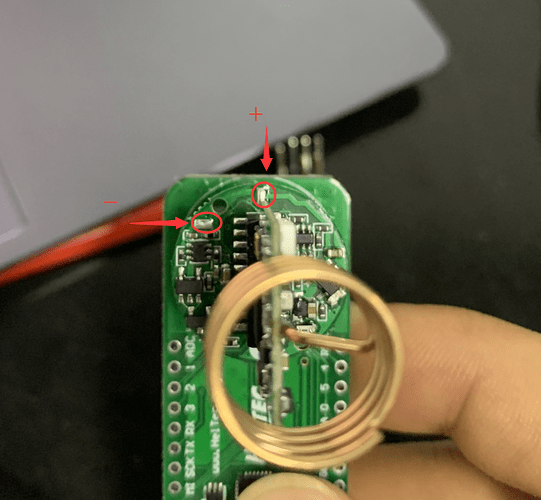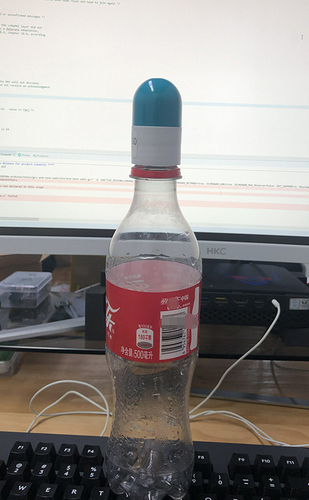[RELEASE] CubeCell Series LoRa Node solution release!
We were often asked questions about the Capsule sensor’s screw nut… Hope this picture can make a direct sense to you.
When we design the capsule sensor, we hope users can do some basic test immediately, users can insert various sensors with a basic shell.
So, we don’t think there is anything easier than finding a cola bottle all over the world.
.stl file for 3D print (Thanks to @rsmedia for sharing): https://github.com/HelTecAutomation/ASR650x-Arduino/tree/master/3D_Print/HTCC-AC01
Since the CubeCell series appear to be a new product line, could you please confirm what EXACTLY each order delivered would contain?
Most importantly what does the core CubeCell Capsule contain:
it appears no antenna is included and also no lithium battery is included.
Could you please confirm how the appropriate antenna is and exactly where it would be connected?what is the recommended lithium battery form factor? an example of a battery which has been tested and a URL to it.
It appears @rsmedia has found one such suitable battery. Any Aliexpress or taobao sources???
Since an antenna makes a huge difference in an RF circuit, I need a bit more explanation as to how this heltec product is handling out transmission
Re: batteries, If you’re not in Europe and can’t order from the supplier that Raystream recommended here:
i.e.:
https://www.wasn.eu/p/akku-100mah-fuer-capsule
then I’m hopeful, although not entirely certain, that these which I’ve ordered but not yet received will be suitable:
@sronan, thanks for your info for the battery. I live in Canada
Could someone please comment on the antenna that is used with the CubeCell capsules?
the batteries stated in the aliexpress link are fine for the capsule.
the antenna is a helix one.

Hi Gipsyblue
It great that your looking for good IoT solutions.
For your information the Capsule antenna as shown is a helical coil and will have a gain of - 2dB to -3dB ( Loss). It will also be effected by what is around it, or what it is placed on and will often have less gain and the antenna radiation pattern can be very varied, with nulls and black spots.
Where there is not such a size restriction, such as in Agriculture you can use a better antenna, probably giving twice the range. After work 30+ years in Radio systems and on many Cellular major networks, the one critical aspect is a good antenna for both the gateway and the nodes.
With a strong signal you can have a smaller spreading factor on some system of 5 or 6 and the time of transmission is reducing significantly E.g. for the same payload of 29 bytes and SF7 67ms compare to SF12 at 1646ms. This give a reduction of life on the same battery from 624 day to 48 days.
One of the key things in Agriculture as in other Industrial applications it is less about the sensors and more about how it work in the field with high or low temperatures, what is nearby, and that its located in a robust box, with a robust antenna. A lot of the cost of the leading brands for Agri sensors in in these design aspects as the environment in a Greenhouse, Cattle shed or in a Field situation can be harsh.
Personally, I would use a CubeCell product which is a good product, but the board version and place it in a robust box, with a sealed area for the sensors or sensor connections. In addition use a good ground isolated antenna such as a sleeve dipole external antenna, that has a well-defined gain and is not effected very much by how it is placed.
The Capsule type is good for some application, such as monitoring “Shock levels” in goods and parcels, where it is small and self-contained but is not located in a very harsh environment.
I hope the above helps, 30 years +, of working in practical deployed radio systems, shows you that Its not that simple and a lot can and does go wrong often not related to the basic design.
Simon
Thanks, that’s helpful. Does that helix antenna come integrated into the capsule or does it need to be ordered separately? If the latter, could you (or anyone) recommend a source?
The antenna is included
The one in your hand is an 868MHz version? But the pogo antenna seems incorrect…At least I can be sure that the antenna is wrong.
I received my order this afternoon (Am in Canada) yes the capsule version has a built in antenna and you do not need to go look and buy a new one. Please note my version is the US 915 MHz
@Simon. Well said. I am also an RF engineer -36 years hands on experience.
Your emphasis on environment of usage cannot be overemphasized! I do agree that for real world usage, the board version of the CubeCell series makes more sense.
What I am looking for now is a suitable housing for the dev board plus power supply. Hopefully there is an IP67 housing available at a reasonable price.
BTW, I received my order for the dev board and capsule versions of the CubeCell series for US915 region.
For the visually inclined this is what it contained
I received a couple of CubeCell boards today and have been playing around a bit to get the lay of the land with these new toys. I have a number of sketches running on several different Dev boards, including the WiFi LoRa 32 and WirelessStick Lite boards (all AUS915). I’m trying to modify some of these sketches to get the CubeCell running in my current environment (simple LoRa, not LoRaWAN at this stage) before tying to do anything new.
So my first question is, I hope, quite simple… What are the pins I need to specify to initiate LoRa on the CubeCell? The relevant code segment from the sketch that runs on the other modules (WiFi LoRa 32 and Wireless Stick Lite) is:
#include "LoRa.h"
#include "Arduino.h"
#define BAND 917E6
#define spreadingFactor 9
#define SignalBandwidth 31.25E3
#define preambleLength 8
#define codingRateDenominator 8
#define SS 18
#define RST 38
#define DI0 26
bool PABOOST = true;
void setup() {
LoRa.setPins(SS,RST,DI0);
if (!LoRa.begin(BAND, PABOOST)) {
while (true);
}
•
•
•
What are the CubeCell specifications for SS, RST and DI0 in the call to LoRa.setPins and can/do I just set up the other definitions and thereafter call LoRa.begin, as in the segment above, to set the operating frequency?
I do note that I have a bit more work to do to configure LoRa WAN, but can I just run LoRa on the CubeCell like the other modules?
Thanks, and sorry if this is is all documented somewhere—if it is, please just point me in the right direction and I’ll go away and read a bit more.
I think you can use these librarys:
Those libraries seem to be structured somewhat differently to the ones I’ve been using for the other LoRa nodes, which is not all that unexpected I guess, since much of the hardware is new. In particular though, LoRa_APP.cpp is just the tip of what looks, at a glance, like a lot more of an iceberg than you see in the regular LoRa.cpp. Correlating the two in order to identify the relevant parameter settings or function calls doesn’t appear to be all that straightforward. Most of the ‘action’ now seems to happen in the Radio routines, but even there any correlation between the register names there and in the current LoRa routines is not immediately obvious.
If we’re operating on a nicely layered model here, the underlying LoRa [PHY] layer would be set up before LoRaWAN [MAC] could do its stuff, but it’s looking like the two might be a little more tightly entwined at this early stage of development. I do note that, right near the top of the LoRa_APP,cpp file, there is the following [‘upwards’] reference to LoRaWAN:
extern uint8_t AppData[LORAWAN_APP_DATA_MAX_SIZE];
which I would not have expected to see in a strict implementation of a layered model.
So I guess my question might now become “Have the LoRa and LoRaWAN functions been ‘separated’ in the current libraries?”, or is that something that is waiting to appear on a To-Do list at some point in the future?
I was hoping to use the CubeCell in a local ‘IntRAnet of Things’. This network currently uses a proprietary MAC Layer protocol, simply because there were issues with LoRaWAN gateways when I started out on this journey. My present arrangement works, so I have been happy to let LoRaWAN mature a little before investing the effort required to make the change.
The advantage of a layered model is that the implementation is unimportant as long as the interfaces are well defined.
I cant say anything of the implementation of the LoRAWan-specifikation. The examples work.
While this is an open question, the input of those located in the EU, the US and Canada and @Supporter will be very much appreciated. This includes @Sivaelid
@rsmedia, I notice that you have some Lithium Polymer battery listed on the WASN website. How was the supplier able to ship from China to you in Germany??
I have been checking for Canadian rules and things are not clear at all. It appears UPS and Fedex can carry batteries. The sub question is should the battery be located inside an equipment or as separate individual items?
So far it has been next to impossible to buy or find this size of battery here
Dont know how the my supplier can ship the lipos to me in germany.
I can ship lipos worldwide but i have to package them in a lipo bag and pay very high postage.
Shipping via air is not possible Only Land and sea.
Hi In Uk only DPD can deliver Batteries . Batteries are used in Drone so look out for that. You look like you can order via Amazon.ca . There seem to be many regulation on battieries but can carry on airline if in appliance if less than 100WH these battieries are arround 4WH. it when thay are transported in bulk is issue. The Chinese carriers often send quantities via container then use local firms to send in normal post. to cusotmers this is how they have very low postage cost.
Good hunting simon


